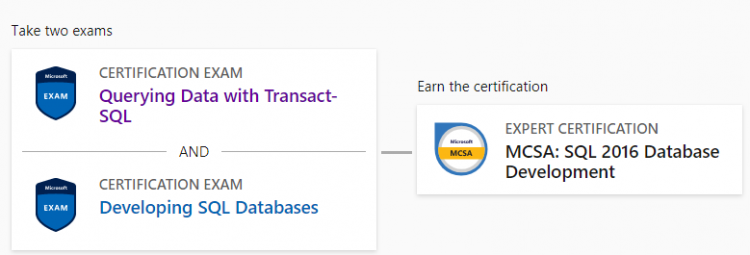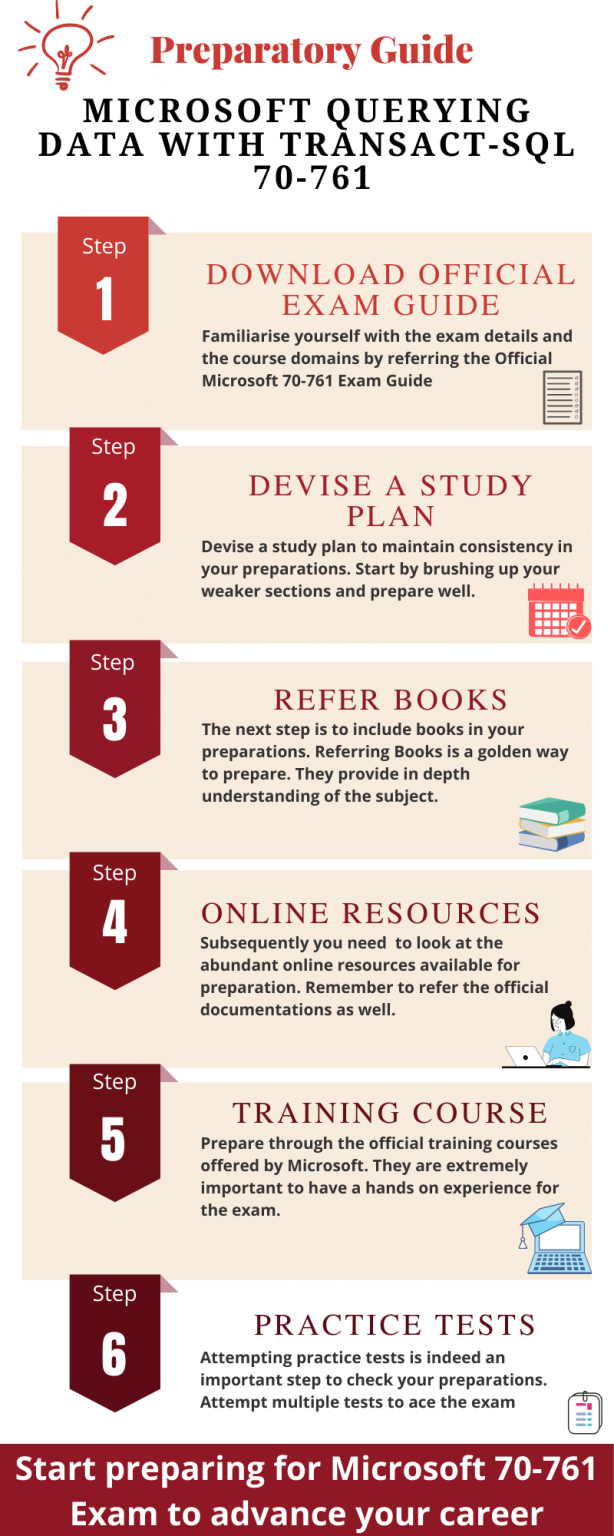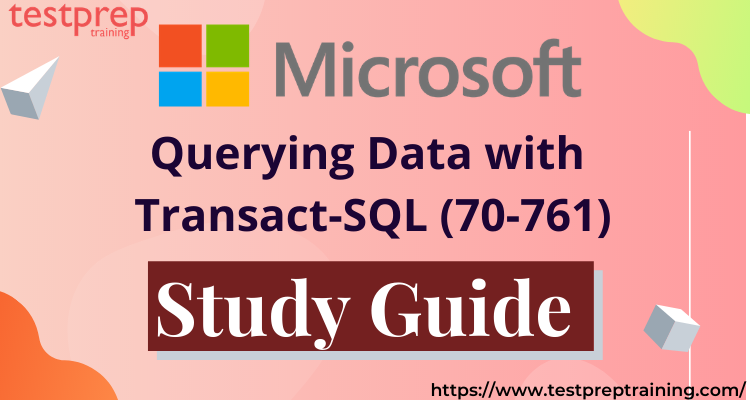Microsoft Querying Data with Transact-SQL 70-761 exam is one of the first exams related to querying data with Transact in SQL Server. This exam validates your mastery of SQL Server 2016 Transact- SQL data management, database programming and queries. Furthermore, this exam allows you to confirm that you have the skills and knowledge needed to handle and search through data and to create programs for databases. It covers a lot of topics, so you need to learn them deeply. Passing the Microsoft 70-761 exam can boost your career and take you to new levels of success.
Microsoft Exam 70-761 Details
The Microsoft 70-761 exam is your first step towards earning the MCSA certification.
When you pass both the Microsoft 70-761 and Microsoft 70-762 exams, you earn the Expert Certification of MCSA: SQL 2016 Database Development. This certification shows that you’re skilled in working with databases, whether they are on-site or in the cloud.

Objectives of Microsoft Exam 70-761
Microsoft Querying Data with Transact-SQL 70-761 exam focuses on the following objectives-
- Firstly, filter, sort, join, aggregate, and modify data
- Secondly, use sub queries, table expressions, grouping sets, and pivoting
- Then, Query temporal and non-relational data, and output XML or JSON
- Also, create views, user-defined functions, and stored procedures
- Lastly, implement error handling, transactions, data types, and nulls
Target Audience for Microsoft Exam 70-761
This exam is for people who work with SQL Server databases, like administrators, engineers, and developers. It’s a way for them to prove they’re skilled at writing queries. Additionally, it’s meant for IT professionals who want to move up the ladder by improving their problem-solving and decision-making abilities, which are important for the MCSA level.
Study Guide for Microsoft Exam 70-761
The key to passing an exam is to prepare correctly. Preparation requires being consistent and determined. We offer you our carefully crafted study guide to assist you in obtaining the Microsoft 70-761 Exam Certification on your first try. Let’s go through it step by step.

Step 1- Refer the Official Exam Guide
To start, it’s essential to read the official guide of Microsoft 70-761 exam before you begin preparing. Get to know all the goals and topics of the exam thoroughly. Also, allocate sufficient time to each subject and aim for a deep understanding. This exam includes three main areas:
Domain 1- Manage data with Transact-SQL (40–45%)
Create Transact-SQL SELECT queries
To begin with, this domain focuses on topics like- Identify proper SELECT query structure, write specific queries to satisfy business requirements, construct results from multiple queries using set operators, distinguish between UNION and UNION ALL behaviour, and identify the query that would return expected results based on provided table structure and/or data
Query multiple tables by using joins
Write queries with join statements based on provided tables, data, and requirements; determine proper usage of INNER JOIN, LEFT/RIGHT/FULL OUTER JOIN, and CROSS JOIN; construct multiple JOIN operators using AND OR; determine the correct results when presented with multi-table SELECT statements and source data; write queries with NULLs on joins
Implement functions and aggregate data
Construct queries using scalar-valued and table-valued functions; identify the impact of function usage to query performance and WHERE clause sargability; identify the differences between deterministic and non-deterministic functions; use built-in aggregate functions; use arithmetic functions, date-related functions, and system functions
Modify data
Write INSERT, UPDATE, and DELETE statements; determine which statements can be used to load data to a table based on its structure and constraints; construct Data Manipulation Language (DML) statements using the OUTPUT statement; determine the results of Data Definition Language (DDL) statements on supplied tables and data
Domain 2- Query data with advanced Transact-SQL components (30–35%)
Query data by using sub queries and APPLY
Subsequently, this domain Determines the results of queries using sub queries and table joins, evaluates performance differences between table joins and correlated sub queries based on provided data and query plans, distinguish between the use of CROSS APPLY and OUTER APPLY, write APPLY statements that return a given data set based on supplied data
Query data by using table expressions
Identify basic components of table expressions, define usage differences between table expressions and temporary tables, and construct recursive table expressions to meet business requirements
Group and pivot data by using queries
Use windowing functions to group and rank the results of a query; distinguish between using windowing functions and GROUP BY; construct complex GROUP BY clauses using GROUPING SETS, and CUBE; construct PIVOT and UNPIVOT statements to return desired results based on supplied data; determine the impact of NULL values in PIVOT and UNPIVOT queries
Query temporal data and non-relational data
Query historic data by using temporal tables, query and output JSON data, and query and output XML data
Domain 3- Program databases by using Transact-SQL (25–30%)
Create database programmability objects by using Transact-SQL
Further, this domain creates stored procedures, table-valued and scalar-valued user-defined functions, triggers, and views; implement input and output parameters in stored procedures; identify whether to use scalar-valued or table-valued functions; distinguish between deterministic and non-deterministic functions; create indexed views
Implement error handling and transactions
Determine results of Data Definition Language (DDL) statements based on transaction control statements, implement TRY…CATCH error handling with Transact-SQL, generate error messages with THROW and RAISERROR, implement transaction control in conjunction with error handling in stored procedures
Implement data types and NULLs
Evaluate results of data type conversions, determine proper data types for given data elements or table columns, identify locations of implicit data type conversions in queries, determine the correct results of joins and functions in the presence of NULL values, identify proper usage of ISNULL and COALESCE functions
Step 2 – Devise a Study Plan
Now, you should create a study plan for your preparations. Sticking to your plan will keep you on track and reduce distractions. It’s also a good idea to align your study plan with the exam objectives. Incorporate practical problems and real-life situations into your studies. And don’t forget, starting early and staying motivated are crucial for success.
Step 3 – Books your Best friends!

Books are the most important ingredient of preparation. There are a vast variety of books available in the market which you can use to prepare for the Microsoft 70-761 Exam. Therefore, our suggestion to you would be to find books for the Microsoft 70-761 exam from genuine sources.
We recommend you to refer the Exam Ref 70-761 Querying Data with Transact-SQL by Microsoft Press Store. This book focuses on the critical-thinking and decision-making acumen to get success at the MCSA level.
Step 4 – Learn from Online Resources
There are plenty of Online Resources Available online for the preparation of your Microsoft 70-761 Exam. Each resource tries to offer you clarity about your exam domains. We recommend you to refer the official Microsoft Documentations. Also you can refer the following documentations for further learning-
- Firstly, Database Functions
- Secondly, Transaction Statements
- Further, Tutorial on basic T-SQL operations
- Also, Subquery Fundamentals
Step 6 – Join a community
Online forums and study groups can be incredibly helpful during your exam preparation. They allow you to connect with others who are on a similar journey. You can ask questions about topics you find challenging and learn from your peers’ expertise. Joining a community like this is a valuable step in your preparation process.
Step 7 – Go for a Training Course
Microsoft provides its own Training Courses for the preparation of this Exam. We know that being a practical exam, it requires hands on training. Therefore, to solve this issue Microsoft has come up with training options in two modes. Choose the one that best suits you.
- Instructor Led Training– The Microsoft instructor led training is similar to the traditional classroom training setting. You can in depth understanding of the exam course and hands on experience.
- Online Training– Online Training offered by Microsoft is an ultimate resource for you to prepare. Such training help you learn on your own schedule, at your own pace, and in your own place.
Step 8 – Take Practice Tests
Practice tests are crucial for assessing your readiness. They reveal your strengths and weaknesses, helping you focus on areas that need improvement. Aim to perform better with each practice test. You can find many practice papers online, so be sure to select reliable ones for your preparation. Start practising for Microsoft 70-761 Now!



